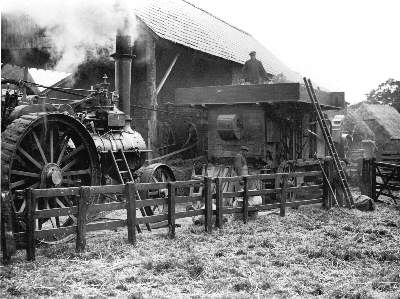|
By the 1870's
The threshing
machine would be towed from farm to farm and then connected to a steam
engine by a long belt drive. The corn would be passed up to the top of
the machine by men using 'pitch' forks. Everyone 'pitched in'.
By the 1940's,
some farms had mobile elevators to do this job. The elevator was also
used during hay-making.
|

Image courtesy
of Rural History Centre, University of Reading
|
 [Geoffrey
Goodson on threshing] [Geoffrey
Goodson on threshing] |
| The
steam engine is in front of the
thresher and the elevator is behind. |
 [John
Gresham on the elevator] [John
Gresham on the elevator] |
The
Second World War changed many things, not least of all; agriculture. Young
men left the land in their thousands to fight for 'King and Country'.
Many were killed and of those that survived, most did not want to return
to a life of toil on the land.
It had been essential to the war effort that food production was increased
to compensate for the lack of imported foodstuffs and so a 'new' workforce
had to be found.
Previous
|
Next |
|
|
|
|

